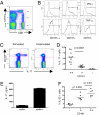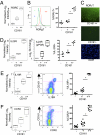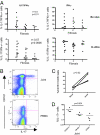Analysis of CD161 expression on human CD8+ T cells defines a distinct functional subset with tissue-homing properties
- PMID: 20133607
- PMCID: PMC2840308
- DOI: 10.1073/pnas.0914839107
Analysis of CD161 expression on human CD8+ T cells defines a distinct functional subset with tissue-homing properties
Abstract
CD8(+) T lymphocytes play a key role in host defense, in particular against important persistent viruses, although the critical functional properties of such cells in tissue are not fully defined. We have previously observed that CD8(+) T cells specific for tissue-localized viruses such as hepatitis C virus express high levels of the C-type lectin CD161. To explore the significance of this, we examined CD8(+)CD161(+) T cells in healthy donors and those with hepatitis C virus and defined a population of CD8(+) T cells with distinct homing and functional properties. These cells express high levels of CD161 and a pattern of molecules consistent with type 17 differentiation, including cytokines (e.g., IL-17, IL-22), transcription factors (e.g., retinoic acid-related orphan receptor gamma-t, P = 6 x 10(-9); RUNX2, P = 0.004), cytokine receptors (e.g., IL-23R, P = 2 x 10(-7); IL-18 receptor, P = 4 x 10(-6)), and chemokine receptors (e.g., CCR6, P = 3 x 10(-8); CXCR6, P = 3 x 10(-7); CCR2, P = 4 x 10(-7)). CD161(+)CD8(+) T cells were markedly enriched in tissue samples and coexpressed IL-17 with high levels of IFN-gamma and/or IL-22. The levels of polyfunctional cells in tissue was most marked in those with mild disease (P = 0.0006). These data define a T cell lineage that is present already in cord blood and represents as many as one in six circulating CD8(+) T cells in normal humans and a substantial fraction of tissue-infiltrating CD8(+) T cells in chronic inflammation. Such cells play a role in the pathogenesis of chronic hepatitis and arthritis and potentially in other infectious and inflammatory diseases of man.
Conflict of interest statement
The authors declare no conflict of interest.
Figures




References
-
- Klenerman P, Hill A. T cells and viral persistence: lessons from diverse infections. Nat Immunol. 2005;6:873–879. - PubMed
-
- Appay V, et al. Memory CD8+ T cells vary in differentiation phenotype in different persistent virus infections. Nat Med. 2002;8:379–385. - PubMed
-
- Lauer GM, Walker BD. Hepatitis C virus infection. N Engl J Med. 2001;345:41–52. - PubMed
-
- Bowen DG, Walker CM. Adaptive immune responses in acute and chronic hepatitis C virus infection. Nature. 2005;436:946–952. - PubMed
Publication types
MeSH terms
Substances
Grants and funding
LinkOut - more resources
Full Text Sources
Other Literature Sources
Medical
Research Materials
Miscellaneous

